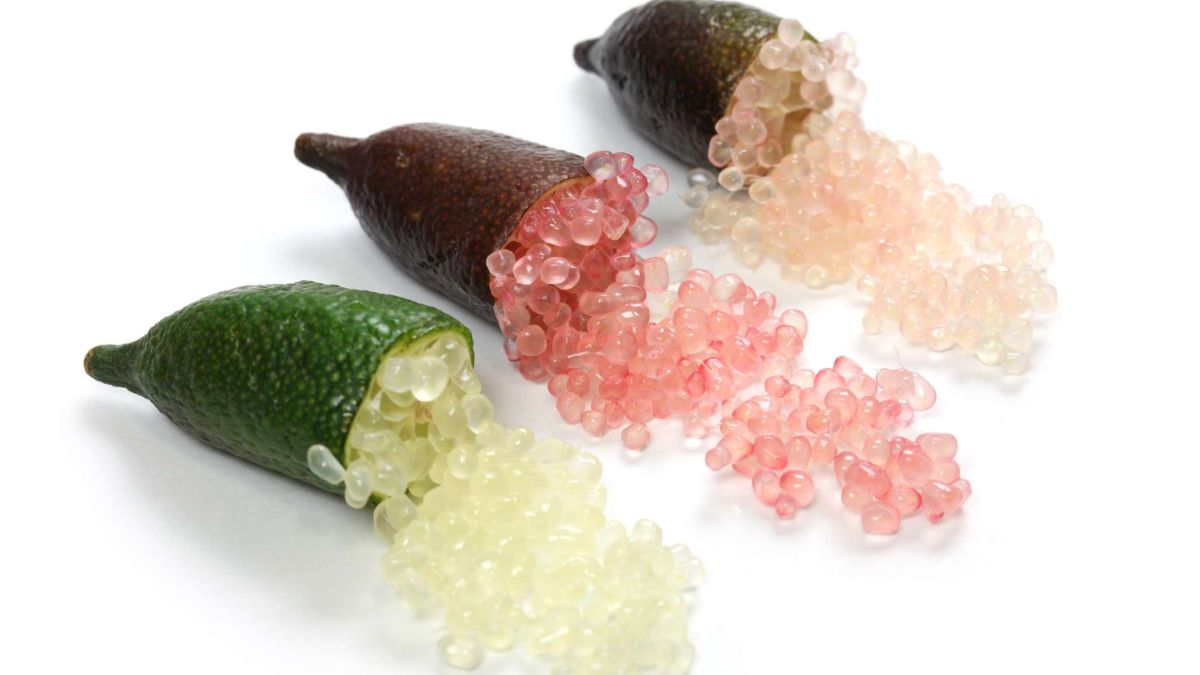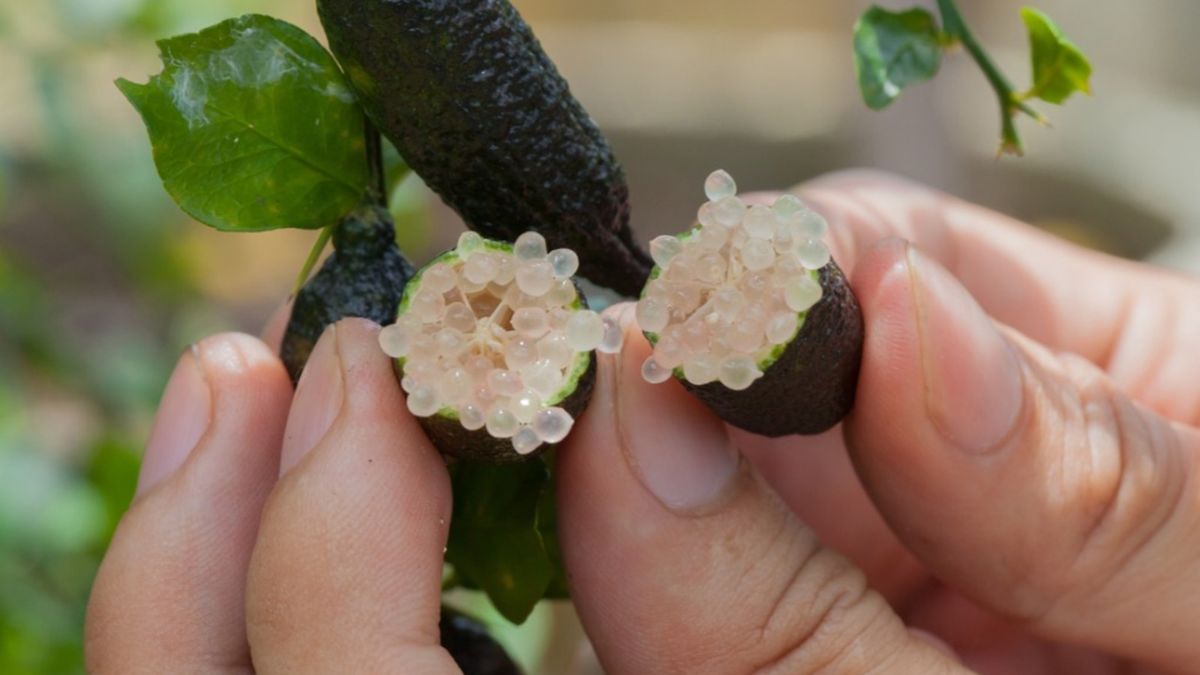Finger limes are a citrus fruit native to Australia but are now grown in North America. They are small and elongated, almost resembling gherkins, containing tiny spherical vessels filled with tart juice, sometimes called citrus caviar.
Finger lime trees aren’t ubiquitous. They can grow up to five metres tall in shady places and are most often found in Queensland and New South Wales rainforests. In other parts of Australia, you can grow finger lime trees. Pests and scales can attack them, so keep a close eye on your tree for signs of disease.
What are Finger Limes?
Finger limes, which are sometimes called Australian finger limes or caviar limes, are a type of citrus fruit from the species Citrus australasica. They are micro citrus that is thought to have evolved in the rainforests of Australia and New Guinea over millions of years.
Finger limes are small fruits that are usually between 2 and 3 inches long and weigh between 10 and 15 grammes. Finger limes look like small pickles or cucumbers with pointed ends. They are often purple or dark green with a blackish tint, but they can also be light green or brownish-red. The fruit’s skin is rough and full of small stones.
But what makes finger limes unique is what’s inside. When you cut them open or break them in half, you can see many tiny sphere-shaped vessels ranging from pale yellowish-green to almost pink. They also have tiny seeds that are cream-coloured. When you squeeze each half, the bubbles come out and can be eaten or used in cooking. They pop in your mouth when you chew them and release a lemony, tart juice. Chefs who use them serve them with seafood, sushi, pasta, and other foods that go well with their crunchy pop and sour, citrusy taste.
The only bad thing about this one-of-a-kind fruit is that it’s expensive. If you can find them, they usually cost between $50 and $100 per pound, depending on how big the package is.
How to Use Finger Limes?
Finger limes go well with fish and seafood because of their fresh, tart citrus flavour. This includes grilled salmon, fresh oysters, sea scallops cooked in a pan, and different kinds of sushi, sashimi, and ceviche. One exciting thing about the tiny bubbles is that they keep the acidic sauce inside until you bite into them. This means they can be placed on top of fish and seafood without the acid breaking down the proteins.
Finger limes are also a popular addition to jams and marmalades. They go well with pasta and sweet fruits, and their tart taste and crisp texture make them a great addition to salads. Lastly, because they look like caviar, they are a tasty and pretty way to top puddings, cheesecakes, ice cream, and other decadent desserts.
- To get the caviar out of the lime, just cut it in half and squeeze each half like you would a tube of toothpaste.
- People have said that the round juice balls look like “lime caviar,” They can be used as a garnish or added to different recipes.
- You get a gassy, sour flavour when you chew on a fresh popsicle.
- The acidity of fruit juice is like that of lime.
- Finger limes can also be used to make jams and pickles.
- Peel from a finger lime can be dried and used as a spice.
- Finger lime can also be used in dressings, jams, sauces, cordials, and cocktails.
- It can be used anywhere you would typically use lemon or lime.
- Finger lime that has been freeze-dried is another exciting thing to add to dukkah.
- You can gently squeeze the pulp out of the skin and use it as a topping for tacos, grain bowls, tofu, green salads, fruit salads, or as a snack on sliced avocado or melons with sea salt.
- The pulp goes well with seafood like salmon on the grill, oyster shooters, scallops seared, sushi, nigiri, and ceviche.
- Finger limes can be used to make marmalades and desserts like cheesecake, ice cream, cookies, cakes, and cream puffs.
- People also like to put them on top of drinks like mojitos, margaritas, martinis, and gin fizz as a floating garnish.
Finger Lime Recipes
Finger limes go well with seafood, sushi, ceviche, salads, and desserts like cheesecake, fruit curd, and ice cream. Here are some recipes that might go well with finger limes.
What do they Taste Like?
Finger limes taste a lot like regular limes. They have a tart, citrusy flavour but a note of rosemary-like herbaceousness and a slightly minty taste. Finger limes come in many different sizes and colours because there are dozens of different cultivars. The beads can be the deep rose, pale pink, pearl, or bright green.
Their round vesicles are firmer than real caviar and make a pleasant sound when you bite into them. Finger limes smell and taste like crushed lemon leaves, which are sour, citrusy, and bitter. Cut a finger lime in half and squeeze it to get out all the little beads.
You can put a spoonful on top of salmon caviar on a bagel (or blini), layer finger lime in sushi rolls, sprinkle them on freshly cooked fish fillets, mix them into mayonnaise, put them on top of sweet lemon tarts or crunchy meringue, or shake them into drinks.
Where to Buy Finger Limes?
Finger limes are grown in California and Florida. You can buy them in the fall, winter, and early spring, and they are sometimes sold at farmers’ markets and specialty food stores like Whole Foods and Wegman’s. You can also buy these fruits online, but you can expect to pay up to $10 per ounce.
Finger Lime Varieties
The most common finger lime varieties in Australia are:
- Pink ice: known for light brown skin and bright pink vesicles.
- Crystal: green skin with pale green cysts, bursting with flavour.
- Crimson tide: dark brown skin with large red blisters, sweet taste.
- Chartreuse: delicate green skin with yellow cysts, bitter flavour.
- Red champagne: red skin with red cysts, sweet flavour.
What are the Health Benefits of Finger Lime?
Without further ado, let’s look at some of the good things finger lime has to offer:
1. Increased Immunity to Infections
Vitamin C is one of the things that finger limes have a lot of. Everyone knows this nutrient helps strengthen the immune system, making the body less likely to get sick from bacteria and viruses. Finger limes can help you feel better when you have the flu or any other infection in your upper respiratory tract.
2. Delayed Aging of the Skin
A lot of vitamin C in finger Lime is excellent for making your skin look young and healthy. This is because it eliminates free radicals, which damage skin cells and speed up the ageing process. Vitamin C also helps your body make collagen, a protein that makes your skin flexible and keeps wrinkles from forming.
3. Healthy Teeth and Gums
Scurvy is a disease that can happen when you don’t get enough vitamin C. It is marked by gums that are red, swollen, and bleeding. Since your gums support and feed your teeth, it is imperative to keep them healthy. If your smile is one of your best features, you should always eat finger limes and other foods with vitamin C that fight scurvy.
4. Boosted Eye Health and Vision
Finger Lime has a significant amount of vitamin A as well. You may already know that vitamin A is essential for keeping your eyes and vision in good shape. Vitamin A protects your eyes from free radicals, which can cause eye diseases and even loss of vision because it is a powerful antioxidant.
5. Defense Against Age-Related Diseases
Finger limes also contain vitamin E. This nutrient has excellent antioxidant properties, just like vitamins A and C. Several studies have shown that it is a perfect way to avoid many health problems with aging. Some of the joints, brain, nerves, and heart diseases.
6. Lowered Blood Pressure
7. Reduced Risk of Iron-Deficiency Anemia
Every serving of finger lime has a good amount of iron in it. Red blood cells, called RBCs for short, can’t be made without this mineral, and RBCs are what help your blood carry oxygen to all parts of your body. Iron-deficient anemia is less likely to happen if you eat finger limes and other iron-rich foods.
Conclusion
Finger limes should be stored in a cool or cold place that is dry. You can keep them at room temperature for a day or two, but if you want to keep them longer, it’s best to put them in the crisper drawer on the low humidity setting (that is, with the vent all the way open), where they’ll stay fresh for two to three weeks. A 100-gram serving of finger limes, which is about 7 to 10 limes, has about 88 percent water, 30 calories, 11 grammes of carbohydrates, 3 grammes of fibre, and almost no protein or fat. It also has 29 milligrammes of vitamin C, 32% of the daily value recommended by the USDA. This makes it a great source of this nutrient.


